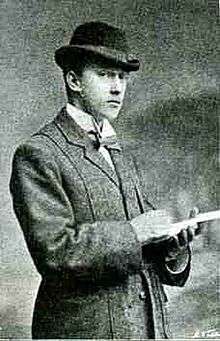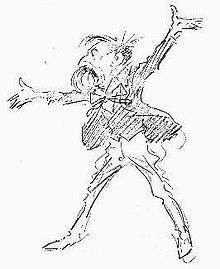Tom Browne (illustrator)
Tom Browne RI born Thomas Arthur Browne (8 December 1870 Nottingham – 16 March 1910 Shooter's Hill), was an extremely popular English strip cartoonist, painter and illustrator of the late Victorian and Edwardian periods.[1][2][3]

Browne started earning a wage as a milliner's errand boy in 1882. From there he was apprenticed to a lithographic printer and eked out a living with freelance cartoons for London comic papers. He received 30 shillings for his first strip, published by the magazine Scraps, and called "He Knew How To Do It".[4]
Comic Cuts, a British comic book was founded by Alfred Harmsworth in 1890. Cheaply printed, it proved to be the ideal medium for Browne's bold drawing style. Browne's comic strips soon became so popular that he moved to London and into a studio in Wollaton House at Westcombe Park. Here he turned out six full-page strips a week, but also managed to produce illustrations for several British magazines. His cartoons appeared in Punch, The Tatler and other highly rated periodicals of the day. The logo of Johnnie Walker whiskey, the strutting, monocled character, was created by Browne in 1908.[5]
Browne was a founding member of the London Sketch Club, and was publicly acclaimed. He became a member of the Royal British Society of Artists in 1898 and was elected to the Royal Institute of Painters in Water Colours in 1901, which allowed him to used the letter RI after his name.[3] His cycling trips took him all over the world, while illustrations of these exploits appeared in the newspapers. Returning to Nottingham, he started a colour printing firm and joined the Territorial Army.
He also created the comic strip Weary Willie and Tired Tim, inspired by Don Quixote and Sancho Panza, which appeared on the front page of Illustrated Chips from 1896 to 1953. Browne played a major part in the evolution of the British comic style, influencing Bruce Bairnsfather, Dudley Watkins and Leo Baxendale. His strip 'Airy Alf and Bouncing Billy' first appeared in The Big Budget around 1900, and was later continued by Ralph Hodgson aka "Yorick". His comic, Dan Leno, portrayed the Victorian English music hall comedian and appeared in Dan Leno's Comic Journal in 1898. Echoes of his impudent urchins can still be seen in The Beano and The Dandy today.[2]
More of his characters were 'Little Willy and Tiny Tim', 'Mr. Stankey Deadstone and Company', 'The Rajah' and 'Don Quixote de Tintogs'. Browne died after surgery for cancer at the age of 39. He was buried with military honours at Shooter's Hill.
Gallery
 Caricature of George Charles Haité
Caricature of George Charles Haité Johnnie Walker logo
Johnnie Walker logo
References
| Wikimedia Commons has media related to Tom Browne (illustrator). |
- "Tom Browne - Lambiek Comiclopedia". lambiek.net. Retrieved 19 September 2014.
- http://yourarchives.nationalarchives.gov.uk/index.php?title=Tom_Browne_and_his_Circle
- "BROWNE, Tom". Who's Who. Vol. 59. 1907. p. 232.
- "TOM BROWNE". Retrieved 19 September 2014.
- "Dr.Whisky: February 2007". Retrieved 19 September 2014.